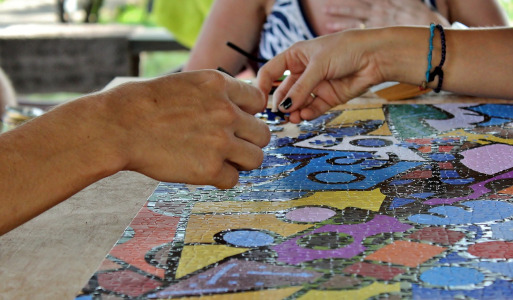Jigsaw puzzle trays? Speed puzzling participants often opt not to use puzzle trays for several reasons, despite their potential advantages. I definitely frown on the idea too. It’s hard to explain, but this one tool that might help you at home playing puzzles is a big hinderance at a puzzle competition.

Don’t Use Jigsaw Puzzle Trays Often?
I’ve got a dozen, or more, jigsaw puzzle trays laying around my house. And I love them when I relax in the kitchen to play jigsaws. However, I would never use the jigsaw puzzle trays for any speed puzzling. I’ve tried but realized this lofty idea turns into a nightmare quickly. Honestly, this makes me lose my focus and I end up not playing my strongest times.
So is this true with every speed puzzle enthusiast? For the most part, jigsaw puzzle trays are an element people leave at home. While there are pros and cons to everything, the reality is that you need to feel comfortable using a tray as you quickly put together a jigsaw. That’s a personal preference too.
Table of Contents
When Speed is an Issue, Use the Table
I’m only one of many speed puzzle enthusiasts, but I think people will agree that you need to put the trays away when it comes to playing. Here are some reasons I’ve been told on why puzzle trays might not be widely used in speed puzzling competitions:
1. Speed and Efficiency is found on a Direct Table Surface.
Using the table surface directly allows speed puzzlers to work more quickly and efficiently. Placing pieces directly on the table minimizes the time spent transferring pieces between trays and the table, enabling a smoother workflow.
2. Better Visibility to See a Clear View of Pieces.
Placing pieces directly on the table provides a clear and unobstructed view of all puzzle pieces. This allows participants to easily spot patterns, colors, and shapes without any barriers, contributing to faster identification and connection of pieces. If you’ve read my speed puzzling tips, you know that you need to use all the elements of the moment to win.
3. Adaptability to Puzzle Complexity is a Dynamic Approach.
Puzzle trays are often designed for specific puzzle sizes or piece quantities. In a speed puzzling competition, participants may encounter puzzles of varying complexities. Working directly on the table allows for a dynamic and adaptable approach that suits different puzzle dimensions.
4. Frequent Rotation of Puzzle Pieces offers Flexibility.
Speed puzzlers frequently rotate the entire puzzle to gain different perspectives. Using puzzle trays might limit this rotational flexibility, as pieces would need to be transferred between trays during rotation. Directly working on the table allows for seamless and continuous rotation. And it gives you a way to visually look at every angle of the puzzle.
5. Minimization of Additional Steps by Reduced Handling of Pieces.
Speed puzzlers aim to minimize any unnecessary steps in the puzzle-solving process. Placing pieces directly on the table eliminates the need for additional handling steps associated with using trays, contributing to a more streamlined and time-efficient approach.
6. Personal Preference: of Most Speed Puzzling Players.
Puzzle-solving strategies can vary based on individual preferences. Some speed puzzlers may find that working directly on the table aligns better with their personal approach and allows them to maintain a faster pace.
Puzzle Trays Are Your Choice
In my opinion, puzzle trays can be beneficial in certain scenarios, especially if you are using them for a puzzle party! Yet the fast-paced and dynamic nature of speed puzzling competitions often leads participants to choose direct table surfaces. When it comes to the light, piece movement and other elements, the faster you want to be the access of the pieces is essential.
The decision ultimately depends on individual preferences, the specific requirements of the competition, and the adaptability needed for different puzzle challenges. Whatever your choice on jigsaw puzzle trays, do what feels best for you! I’ll see you at the puzzle competitions!
